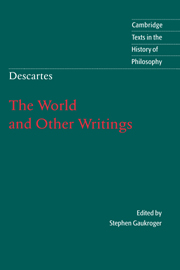Introduction
Published online by Cambridge University Press: 17 December 2009
Summary
The origins of The World
The Treatise on Light and the Treatise on Man – which I shall refer to under the collective title The World – together constitute the most ambitious systematic project that Descartes ever undertook. Neither appeared in his lifetime. The first was published posthumously as Le Monde in 1664, the second two years earlier as Renatus Descartes de Homine. Both are parts of what is ostensibly a single work, and form the backbone of a single treatise. The text went through a number of redraftings, not just with respect to the detail of the arguments but also with respect to what should be included in the treatise, and the project included not only the Treatise on Light and the Treatise on Man, but also the material on the formation of colours in the Meteors and the material on geometrical optics in the Dioptrics, both subsequently published in 1637 along with the Discourse and the Geometry. I have included this material as appendices to the text of the Treatise on Light. There are also indications that Descartes had originally intended incorporating other material, including some work on music, for example, although this is not extant and may never have been developed in a systematic way.
The core doctrine at stake in The World is that of mechanism – above anything else, the doctrine that matter is completely inert – and Descartes' aim is to provide a mechanistic cosmology, resting on the basis of quantitative ‘laws of nature’, and a mechanistic physiology. Among the more fundamental things that he sets out to establish, four are of special significance and novelty.
- Type
- Chapter
- Information
- Descartes: The World and Other Writings , pp. vii - xxixPublisher: Cambridge University PressPrint publication year: 1998

